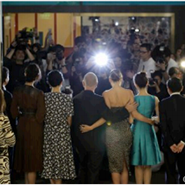- About
- Subscribe Now
- New York,
October 23, 2014

 Michael Kors Jet Set event in Shanghai
Michael Kors Jet Set event in Shanghai
U.S. fashion label Michael Kors' Jet Set collection campaign in Shanghai offers some tactics that luxury brands looking to gain recognition in China should consider leveraging, according to a new report by Resonance China.
The report breaks down each component of the campaign to provide a detailed framework of what occurred and how Michael Kors kept consumers engaged. As brands look to develop brand loyalty in China, campaigns of similar depth and nuance will have to be deployed.
"As China's netizens become more wealthy, increasing numbers of global brands are attempting to establish relationships with them via social media," said Rand Han, founder and managing director of Resonance China. "The problem then is how exactly to establish these connections.
"We created the China Social Branding report to help global marketers quickly understand China social, digital marketing through the eyes of the biggest brands in the world," he said.
The "China Social Campaign Report" for Michael Kors provides detailed analysis of pre-launch, launch and post-launch activities.
Gradually built
Resonance China argues that the Jet Set campaign sought to express an "inspirational lifestyle message" to consumers and the brand achieved this through a sustained and multifarious campaign.
First, Michael Kors piqued interest by posting travel content on Sina Weibo that either featured brand products in various locales or merely appealed to consumers' travel aspirations.
From Resonance China report, courtesy of Michael Kors
WeChat and Sina Weibo contests were then introduced to ensure interaction.
The brand then teamed up with Elle China and social influencers to gain credibility. A microsite was created where influencers displayed their versions of the jet set lifestyle.
From Resonance China report, courtesy of Michael Kors
As the campaign gained traction among key audiences, the brand then introduced the possibility of attending the culminating Jet Set event, that would be hosting many celebrities, through various contests, notably on WeChat.
From Resonance China report, courtesy of Michael Kors
To maximize excitement, the Jet Set event coincided with the Shanghai store opening.
Michael Kors sustained the atmosphere from the Jet Set collection debut for the new flagship with a 360-degree application that ferried fans through the celebration.
The Michael Kors Jet Set Experience
The brand introduced the store with an exclusive runway show, 3D visuals and various projections. In addition to the encapsulating microsite, Michael Kors gave fans a sense of the evening’s progression and what it would have been like to attend with the MK360 app (see story).
Throughout the event, the brand engaged consumers and supplied content on various social platforms.
Afterward, the brand adapted content from the evening to keep interest in the Jet Set collection alive.
Overall, the brand created 76 posts during the teaser phase, 27 during the launch phase and 29 during the post-launch phase.
According to the report, Sina Weibo measured 176,957 total engagements and 62.7 million views from the campaign.
Shifting dynamics
Luxury brands managed to reap huge profits with crude strategies in China a few years ago, but now only smart marketers versed in cultural norms will survive, according to a China Luxury Advisor partner at Luxury Interactive.
As brands initially set up operations in China, they struggled with awkward localization efforts, overexpansion, sluggish online activities, poor choice of local partners, miscommunications and more. Such mishaps today are becoming unacceptable and brands that want to succeed in China must adhere to several guiding principles (see story).
A report by Boston Consulting Group explores the online shopping tendencies of Chinese consumers such as a widely-held penchant for researching products at length.
“The Chinese Digital Consumer in a Multichannel World” report explains that the number of Chinese online shoppers is expected to reach 380 million by 2016, which presents brands with huge swaths of potential customers. Any giddiness marketers feel at such a prospect should be tempered by the fact that only .5 percent of online activity is conducted on brand or company Web sites (see story).
For brands looking to stake a place in China, integrating into local cultures will facilitate any campaigns.
"Find a balance between global brand message/heritage/ambassadors, with local perspective and China celebs/influencers," Mr. Han said.
"Align with Chinese consumer aspirations - travel, global lifestyle," he said. "Bring global brand ambassadors together with China celebs is a great way to make a splash, but maximize the event. Bridge offline to online [to] extend reach and sustain buzz through social and digital."
Final Take
Joe McCarthy, staff writer on Luxury Daily, New York
Share your thoughts. Click here